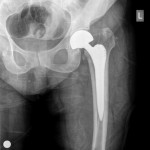
In December 2012 the American Academy of Orthopaedic Surgeons and American Dental Association (ADA) reviewed the evidence of links between dental procedures and developing a prosthetic joint infection (PJI). At that time they recommended that:-
The practitioner might consider discontinuing the practice of routinely prescribing prophylactic antibiotics for patients with hip and knee prosthetic joint implants undergoing dental procedures.
In 2014 the ADA convened a panel of experts to address the question;
For patients with prosthetic joints, is there an association between dental procedures and PJI, and, therefore, should systemic antibiotics be prescribed before patients with prosthetic joint implants undergo dental procedures?
Methods
Searches conducted for the 2012 review were updated. New studies identified together with all article reviewed at full-test stage of the 2012 review were considered. All studies were screened independently and in duplicate and studies were critically appraised. The expert panel approved the clinical recommendation and it was peer reviewed before being finalised and approved by the ADA Council on Scientific Affairs.
Results
- 4 case-controlled studies were included
- A narrative summary of each of the 4 studies is presented and appraisals of them are presented in a tabular format.
- 3 out of 4 of the studies did not find an association between dental procedures and PJIs.
| The Panel made the following clinical recommendation:
In general, for patients with prosthetic joint implants, prophylactic antibiotics are not recommended prior to dental procedures to prevent prosthetic joint infection. For patients with a history of complications associated with their joint replacement surgery who are undergoing dental procedures that include gingival manipulation or mucosal incision prophylactic antibiotics should only be considered after consultation with the patient and the orthopaedic surgeon. To assess a patent’s medical status a complete health history is always recommended when making final decisions regarding the need for antibiotic prophylaxis. |
Conclusions
The authors concluded
Evidence fails to demonstrate an association between dental procedures and PJI or any effectiveness for antibiotic prophylaxis. Given this information in conjunction with the potential harm from antibiotic use, using antibiotics before dental procedures is not recommended to prevent PJI. Additional case- control studies are needed to increase the level of certainty in the evidence to a level higher than moderate.
Commentary
This update of the 2012 joint guideline has only been developed by the ADA, although consultation has included other stakeholders, including for example, Infectious disease experts, pharmacists and orthopaedic surgeons. The guideline is based on 4 case-control studies, which are more prone to bias and confounding. The studies adjusted for a range of confounders that varied from study to study and there was also marked variation in how accurately exposure (to dental treatment) was measured. Overall the expert group determined that the level of certainty was moderate using the ADA’s criteria. However, these may not be fully consistent with the GRADE criteria, which should be considered.
Links
Sollecito TP, Abt E, Lockhart PB, Truelove E, Paumier TM, Tracy SL, Tampi M, Beltrán-Aguilar ED, Frantsve-Hawley J. The use of prophylactic antibiotics prior to dental procedures in patients with prosthetic joints: Evidence-based clinical practice guideline for dental practitioners-a report of the American Dental Association Council on Scientific Affairs. J Am Dent Assoc. 2015 Jan;146(1):11-16.e8. doi: 10.1016/j.adaj.2014.11.012. Epub 2014 Dec 18. PubMed PMID: 25569493.

Don’t miss – Prosthetic joints: prophylactic antibiotics not required for dental work http://t.co/1EBOQBUl1s